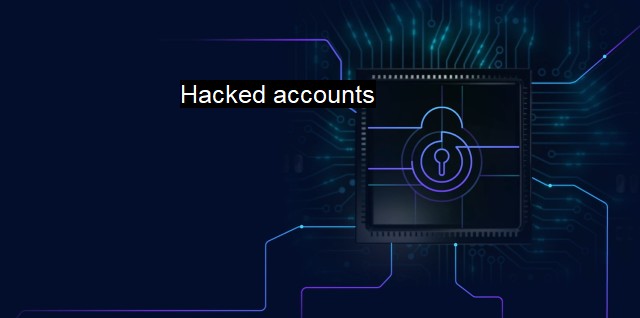What are Hacked accounts?
The Cost of Hacked Accounts: Understanding the Risks and Importance of Cybersecurity Measures to Prevent Financial and Personal Loss
In the technologically advanced world we live in, increasing internet use has given rise to a new breed of crimes, a prominent one being "Hacked Accounts". This term refers to situations where an individual maliciously gains unauthorized access to someone's digital account, breaching the very integrity of sensitive data and privacy. While no platform remains entirely safe from hacking, victims often consist of users from e-commerce sites, social media platforms, email clients, corporate databases, and digital banks."Hacked accounts" stand as clear indicators of a trespass showcasing a range of possible vulnerabilities. Hackers can deploy various cyber methodologies to take control of these accounts. Indicative of a compromise, wired activities such as unauthorized postings, unusual transactions, foreign emails or text messages, unrecognized device logins, unauthorized password changes, and personalized information alterations theoretically provide evidence of account hacking.
Across the spectrum, there are multiple hacking tactics used to infiltrate accounts. Phishing remains the most prevalent, tricking users into revealing their access credentials through counterfeit email warnings or false website interfaces. Another approach involves hackers exploiting password recovery options to manipulate and reset user passwords. Cybercriminals often resort to brute force attacks or use complex algorithms to forecast passwords, making weak or commonly used passwords quite susceptible to hacking efforts.
Malware insertion is another sophisticated method for seizing control of accounts. They implant harmful bots, viruses, or ransomware into user's device through corrupted files, dubious emails or suspicious webpages. Once inside, these cyber threats can track, alter, or provide clear gateways to the user's private data.
It necessitates emphasizing how hacked accounts can generate real-world consequences. Cybercriminals, once they infiltrate the account, can commit fraudulent actions, propagate misleading information, utilize stolen credentials in identity theft crimes, or leak confidential data.
As daunting as the threat is, numerous solutions for safeguarding digital accounts exist. Antivirus software plays a critical role in stopping and removing malware attacks, highlighting any harmful content trying to enter the surrounding digital system. Generally, it scientifically deciphers the constituent code of every program or file entering the user device, sidelining suspicious ones while alerting the user.
Encryption is another prominent cybersecurity practice to fend off hacking. By transforming readable data into coded text, it ensures end-to-end protection of data communication from sender to receiver. Even if hackers manage to intercept data during transit, the encrypted form remain useless without decryption knowledge, effectively locking out any prying eyes.
Stronger passwords, multi-factor authentication, ensuring application update to their latest versions, refraining from clicking on unfamiliar links and emails, and backing up essential data regularly can provide incremental protections on receiver end. Proper usage knowledge and discretion round up the two key pillars supporting digital safety, significantly reducing chances of account hacking.
Perhaps the direst lesson in cybersecurity lied in understanding that every internet user is vulnerable, and relaxing safety measures can lead one to fall victim to hacked accounts. Yet, as formidable as the threat is, the continuously evolving world of cybersecurity stays on its toes, offering guardrails after guardrails to combat the evolving tricks of hackers. From trusty antivirus defenses to public awareness programs, the fight against hacked accounts is as ardent as it gets.
"Hacked accounts" represent a breach ranging primarily from sensitive data exploits to identity theft. Protective solutions like antivirus software, multi-factor authentication, regular data backups, and the careful handling of suspicious content offer relief. But fundamentally, vigilance remains the strongest deterrent, championing the battle to safeguard our digital lives from the bane of hacked accounts.

Hacked accounts FAQs
What should I do if I think my account has been hacked?
If you think your account has been hacked, you should immediately change your password and enable two-factor authentication if available. You should also contact the customer support for the service where your account was hacked to report the issue, and monitor your account for any suspicious activity.How can I prevent my accounts from being hacked?
To prevent your accounts from being hacked, you should use strong, unique passwords for each account and never reuse passwords across multiple services. You should also enable two-factor authentication whenever possible, and be cautious of phishing scams and suspicious links. Keeping your antivirus and cybersecurity software up-to-date is also important.What are the risks of having a hacked account?
Having a hacked account can put your personal and financial information at risk, as well as compromise your online reputation. Hackers may use your account to send spam or malicious links to your contacts, or to gain access to other accounts linked to your email or social media profiles.Can an antivirus software protect me from having my accounts hacked?
While antivirus software cannot directly prevent your accounts from being hacked, it can protect your device from malware and other digital threats that may lead to a hacking attempt. Antivirus software can also detect and remove any malicious software already present on your device, reducing the risk of future attacks. However, it's still important to follow other best practices for online security, such as using strong passwords and being cautious of phishing scams.| | A | | | B | | | C | | | D | | | E | | | F | | | G | | | H | | | I | | | J | | | K | | | L | | | M | |
| | N | | | O | | | P | | | Q | | | R | | | S | | | T | | | U | | | V | | | W | | | X | | | Y | | | Z | |
| | 1 | | | 2 | | | 3 | | | 4 | | | 7 | | | 8 | | |||||||